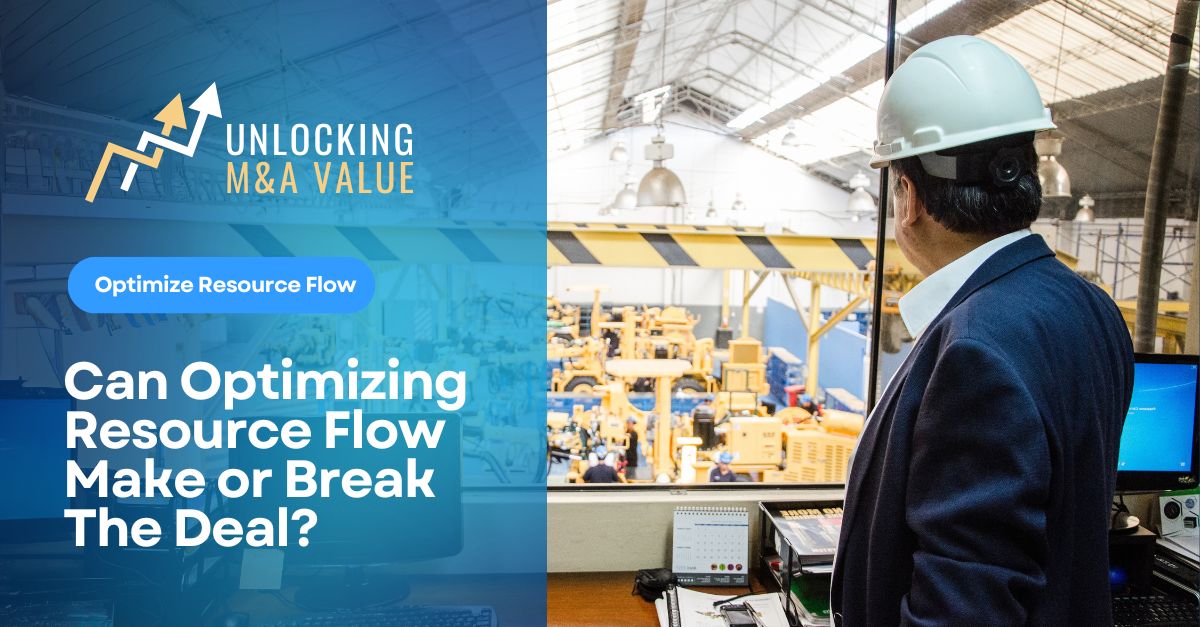
Justin Pethick, Senior Vice President of Strategy & Business Development, POWERS
In M&A, every dollar counts, and every risk matters. However, as dealmakers pore over financials and synergies, one critical factor often gets short shrift: the flow of resources across the value chain.
At POWERS, we’re focused on optimizing resource flow this month and believe inefficiencies here—such as excess inventory, delayed parts, or bloated processes—can make or break a deal. A lean tool called Value Stream Mapping (VSM) could be the key to spotting these deal-shapers early. Is it part of due diligence? If not, should it be? Let’s dig in.
The Hidden Deal-Killer: Resource Flow Inefficiencies
Resource flow is the heartbeat of manufacturing—materials, parts, and information moving from supplier to customer. When it’s streamlined, margins thrive; when it’s choked, costs spiral. In M&A, inefficiencies in this flow can tank valuations or derail integration. Imagine an automotive target with strong products but a supply chain stalled by late deliveries. Its EBITDA suffers, buyers hesitate, and the deal price takes a hit. Or, picture a food and beverage firm hoarding inventory—cash is trapped, and integration becomes chaotic.
These aren’t mere operational quirks; they’re valuation landmines. For PE firms, portfolio companies with sloppy resource flows signal risk, depressing multiples. In M&A, buyers may discount targets with hidden waste, while sellers who overlook these issues leave money on the table. However, traditional due diligence often skims this, prioritizing financials or IT systems.
Value Stream Mapping: The X-Ray for Resource Flow
Value Stream Mapping (VSM), developed at Toyota, visualizes material and information flows, exposing waste like excess inventory, delays, or overprocessing. It’s a diagnostic tool that maps every step, from raw material to finished product, to pinpoint inefficiencies. A semiconductor manufacturer used VSM to cut inventory costs and accelerate time-to-market, boosting its M&A appeal.
In M&A, VSM could transform due diligence. By mapping a target’s value stream, buyers can quantify the impact of waste—say, $10 million in tied-up inventory or 20% longer lead times—and adjust bids or plan fixes accordingly. Sellers who use VSM pre-sale can optimize their flows, lift margins, and command premiums. It’s a way to see the real value beneath the surface.
Is VSM Part of Due Diligence? Should It Be?
VSM isn’t standard in M&A due diligence. Deal teams assess operations broadly, encompassing supply chain and production KPIs, but rarely employ VSM’s granular, visual approach. Time constraints and lack of lean expertise may be the culprits, but this gap is a missed opportunity.
It absolutely should be part of due diligence. VSM quantifies waste, stress-tests operational claims, and estimates synergy potential. Buyers can spot red flags—like a target’s “efficient” supply chain that’s anything but. PE firms can identify portfolio fixes, as one client did, cutting production costs by 15% pre-exit using VSM insights. Sellers can polish operations, signaling strength. The challenge? VSM requires data access and time, which tight timelines can squeeze. However, the payoff—smarter bids, smoother integrations—is undeniable.
Turning Resource Flow Into Deal Value
How do you make VSM work for M&A? Start with diagnosis, then lock in gains. VSM maps the path to efficiency, but sustaining it requires real-time visibility. That’s where tools like our DPS platform come in, codifying VSM’s optimized processes and monitoring KPIs like capacity utilization or downtime to ensure results stick. For sellers, VSM pre-sale tightens flows, boosting valuation. Buyers and PE firms should push for VSM in due diligence to uncover risks and opportunities others overlook.
Post-deal, VSM drives synergy capture. Streamlined flows mean faster integration, higher margins, and stronger exits. A pharmaceutical firm utilized VSM to reduce waste by 25%, transforming a shaky acquisition into a standout. With a tool like DPS tracking KPIs, those gains would hold firm.
The Deal-Clincher
Resource flow isn’t a side note—it’s a deal-clincher. Inefficiencies can hide a target’s worth or inflate its risks, while an optimized resource flow signals value. As M&A activity accelerates in 2025, VSM could give dealmakers a competitive edge.
About POWERS
At POWERS, we help private equity firms and manufacturers unlock value quickly. Our team digs into operations—processes, workforce, supply chains, maintenance—to drive efficiency and accountability. We deliver real value: higher output, lower costs, and teams aligned to your vision. Our DPS platform takes it further, codifying optimized processes from Value Stream Mapping and monitoring production KPIs in real-time, ensuring your M&A gains endure. Want to maximize your next deal? Let’s talk.
- Speak to an Expert: Call +1 678-971-4711 to discuss your specific challenges and goals.
- Email Us: Get tailored insights by emailing info@thepowerscompany.com
- Request an Assessment: Use our online contact form, and one of our expert manufacturing consultants will reach out to schedule an in-depth analysis of your operations.

